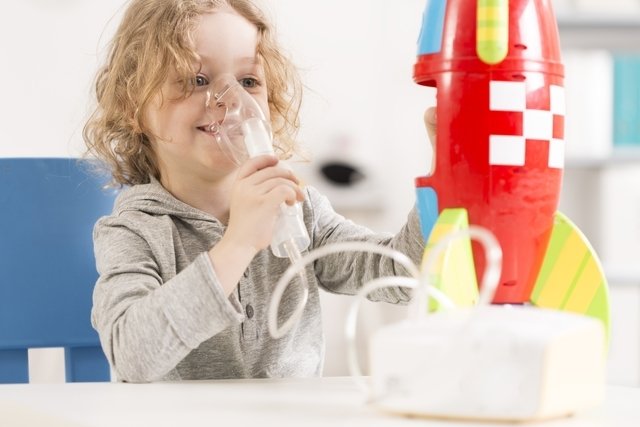Cystic fibrosis is a chronic genetic disease that causes the production of very thick and viscous secretions, especially in the lungs and digestive tract. It is caused by a change in the CFTR protein, which regulates the functioning of the body’s glands.
Symptoms of cystic fibrosis tend to appear in childhood and appear gradually, affecting quality of life. The most common symptoms are difficulty breathing, a constant feeling of shortness of breath and frequent respiratory infections. In addition, there may be digestive symptoms, such as constipation and the production of bulky, greasy and foul-smelling stools.
There is no cure for cystic fibrosis, but there is treatment, which should be started as early as possible to prevent the disease from worsening quickly and alleviate symptoms, increasing quality of life.

Cystic fibrosis symptoms
The most common symptoms of cystic fibrosis are:
- Feeling of shortness of breath and wheezing when breathing;
- Persistent cough, with phlegm or blood;
- Saltier sweat than usual
- Difficulty breathing after exercise;
- Yellow skin and eyes, in some cases;
- Formation of nasal polyps, which corresponds to the abnormal growth of the tissue that lines the nose;
- Joint pain.
Some people may also develop digestive symptoms, such as bulky, greasy and foul-smelling stools, frequent diarrhea or constipation, poor digestion and progressive malnutrition. Find out more about the symptoms of cystic fibrosis.
Furthermore, due to the accumulation of secretion in the lungs, people with cystic fibrosis are more likely to have chronic sinusitis, frequent pneumonia and bronchitis, and recurrent lung infections.
In babies, the first sign of cystic fibrosis usually happens when the baby is unable to eliminate meconium, in the first or second day of life, but other signs can also be noticed such as difficulty gaining weight and delayed growth.
How to confirm the diagnosis
The diagnosis of cystic fibrosis can be made at birth using the heel prick test. However, to confirm the diagnosis, it is necessary to perform a sweat test and genetic tests to identify the mutation responsible for the disease.
Read too: Heel prick test: when to do it and what diseases it detects
In addition, it is possible for a carrier test to be carried out, which checks the couple’s risk of having children with cystic fibrosis, this test being mainly carried out by people who have a family history of the disease.
If the diagnosis is not made soon after birth, cystic fibrosis can be confirmed through blood tests that allow identifying the mutation responsible for the disease and evaluating specific enzymes that are altered in the case of cystic fibrosis.
Pulmonary function tests may also be requested by the doctor, as well as a chest x-ray or computed tomography, especially when the person presents chronic respiratory symptoms.
To assess your risk of cystic fibrosis, make an appointment with your nearest doctor using the following tool:
Taking care of your health has never been easier!
Possible causes
Cystic fibrosis is caused by mutations in the CFTR gene, which is related to the regulation of the flow of chlorine, sodium and water into and out of cells, playing an essential role in the functioning of glands.
Therefore, in the presence of the mutation, there is a change in the secretory function of these glands, resulting in more viscous secretions and an increase in salt in sweat.
Normally, in the lung airways, there are small structures, called cilia, that help move mucus from the lung toward the nose and mouth for elimination. However, in people with cystic fibrosis, this process is compromised, so that mucus accumulates in the lungs and respiratory symptoms appear.
How the treatment is carried out
Treatment for cystic fibrosis generally involves the use of medications prescribed by a doctor, respiratory physiotherapy and nutritional monitoring, to control the disease and improve the person’s quality of life.
Furthermore, surgery can also be used in some cases, especially when there is obstruction of a channel or when serious respiratory complications occur.
1. Use of medicines
Medicines for cystic fibrosis are used to prevent infections, allow the person to breathe more easily and prevent other symptoms from developing. Thus, the main medications that may be recommended by the doctor are:
- pancreatic enzymeswhich must be administered orally, and which aim to facilitate the digestion process and absorption of nutrients;
- Antibiotics to treat and prevent lung infections;
- Bronchodilatorswhich help keep the airways open and relax the bronchial muscles;
- Mucolytics to help loosen mucus;
In cases where the respiratory system worsens and the patient has complications such as bronchitis or pneumonia, for example, they may need to receive oxygen through a mask. It is important that the treatment indicated by the doctor is followed as prescribed so that the person’s quality of life improves.
Read too: Oxygen therapy: what it is, types, what it is for and care
2. Diet adaptation
Nutritional monitoring in cystic fibrosis is essential, as it is common for these patients to have difficulty gaining weight and growth, nutritional deficiencies and, sometimes, malnutrition. Therefore, guidance from a nutritionist is important to supplement the diet and strengthen the immune system, fighting infections.
The diet of a person with cystic fibrosis should:
- Be rich in calories, as the patient is not able to digest all the food they eat;
- Be rich in fat and protein because patients do not have all the digestive enzymes and also lose these nutrients in the feces;
- Be complemented with supplements of vitamins A, D, E and K, so the patient has all the nutrients they need.
The diet should start as soon as cystic fibrosis is diagnosed, and be adapted as the disease progresses.
3. Physiotherapy sessions
Physiotherapy treatment aims to help release secretions, improve gas exchange in the lungs, clear the airways and improve exhalation, through breathing exercises and devices.
Read too: Respiratory physiotherapy: what it is for and how to do it (with exercises)
In addition, physiotherapy also helps mobilize the joints and muscles of the chest, back and shoulders through stretching exercises.
The physiotherapist must be careful to adjust the techniques according to the person’s needs to achieve better results. It is important that physiotherapy is carried out from the moment the disease is diagnosed, and can be done at home or in the office.
4. Bowel surgery
Bowel surgery is indicated when there is an intestinal obstruction caused by cystic fibrosis, allowing feces to pass through the intestine again.
5. Lung transplant
Lung transplantation may be indicated when pulmonary cystic fibrosis causes serious respiratory problems that can put the person’s life at risk or when the person is resistant to antibiotics, that is, these medications can no longer control the lung infection.
Cystic fibrosis does not recur in the transplanted lung, however, other complications associated with cystic fibrosis, such as sinus infections, diabetes, pancreas disease, or osteoporosis, may still occur after transplantation. Understand how a lung transplant is performed.
Possible complications
Complications of cystic fibrosis occur when treatment is not started or is not sufficient to combat the excess secretions produced, which can have consequences for the functioning of the respiratory and digestive system, for example.
Thus, there may be the development of bronchitis, sinusitis, pneumonia, nasal polyps, pneumothorax, respiratory failure, diabetes, obstruction of the bile ducts, liver and digestive problems and osteoporosis.
Is cystic fibrosis curable?
Cystic fibrosis has no cure, however, it is a disease that can be diagnosed soon after birth, allowing treatment to be carried out as soon as possible to help alleviate symptoms, avoid complications and improve quality of life.
The life expectancy of people with cystic fibrosis varies from person to person, according to gender, adherence to treatment, severity of the disease, and respiratory, digestive and pancreatic clinical manifestations.

Sign up for our newsletter and stay up to date with exclusive news
that can transform your routine!
Warning: Undefined array key "title" in /home/storelat/public_html/wp-content/plugins/link-whisper-premium/templates/frontend/related-posts.php on line 12
Warning: Undefined array key "title_tag" in /home/storelat/public_html/wp-content/plugins/link-whisper-premium/templates/frontend/related-posts.php on line 13



